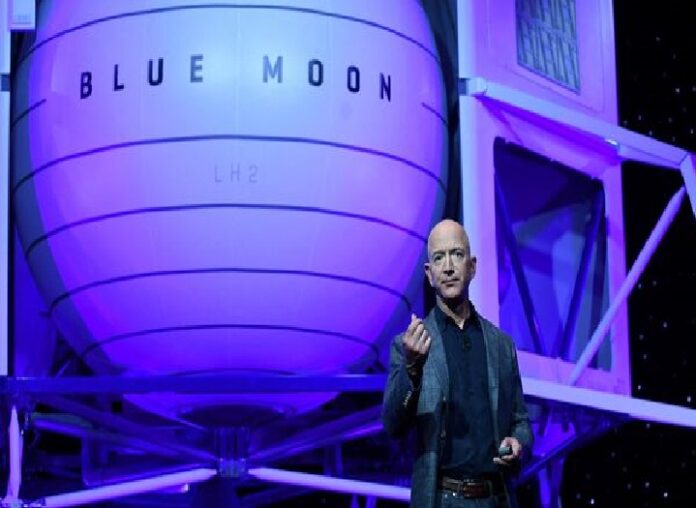Near an empty Florida beach, Jeff Bezos’ space company built a launchpad designed to withstand the flames and roar of powerful rocket engines at liftoff. There is hardly a scratch on it.
Many in the space industry view Bezos’ Blue Origin as a counterbalance to Elon Musk-led SpaceX, which has become virtually a monopoly in the rocket-launch market. They also wonder why Blue Origin isn’t further along. The company hasn’t yet made it to orbit, but is starting to close in on such a mission, producing huge metal sections and components for its fleet of New Glenn orbital rockets in a cavernous factory near the launchpad.
The company, based outside of Seattle, has spread its bets over several businesses, including an engine division and a suborbital space-tourism unit. Along the way, it has built a backlog of orders that stands close to $10 billion. It has almost 11,000 employees, some working on projects aimed at fostering long-term exploration efforts, such as making solar cells out of moon rocks and dust.
Launching New Glenn from the rugged-but-unused pad on Cape Canaveral stands out as a hurdle Blue Origin must show it can surmount. Customers have signed up to fly on the vehicle, and Bezos’ far-reaching goals for space require transport to low-Earth orbit and beyond. The company plans to launch the first New Glenn mission next year—provided the vehicle meets its exacting standards.
“I think everybody wants New Glenn to fly at the earliest time possible. Everybody does,” Bob Smith, chief executive at Blue Origin, said in an interview. “We’re not going to sacrifice doing it right.”
Bezos founded Blue Origin almost 25 years ago, when Amazon.com was an unprofitable website. Shortly after that, Musk plowed money into his own space startup. The entrepreneurs have sci-fi dreams: Bezos predicted that humanity would spread across the solar system, and Musk reminds people that SpaceX’s goal is to make interplanetary travel a reality.
SpaceX has pulled away from Blue Origin, launching its Falcon rockets almost 250 times as of last Saturday, including for human space missions the company is starting to make routine.
The gap between the two companies has drawn notice from space-industry officials and executives.
“Many of us think of Blue Origin as really, truly a potential competitor to SpaceX,” said Thomas Zurbuchen, the former top science administrator at National Aeronautics and Space Administration. “I think for many of us there’s a little bit of a sense of anxiety.”
The two companies’ strategies are different. SpaceX has built a reputation for speed and embracing fireballs when developing rockets. Blue Origin, which once used tortoises on a logo, operated for years like a think tank, with a more cautious, methodical style.
“The advantage is you’re not going to make as many mistakes,” George Sowers, who developed rockets at United Launch Alliance, said of the route Blue Origin has taken. “But SpaceX would say, ‘Hey, making mistakes is how we learn.’”
In April, SpaceX blasted off Starship, its new 394-foot-tall rocket, for the first time from its complex in South Texas. The launch spread debris over hundreds of acres and started a fire. Starship flew for four minutes before an onboard system destroyed it.
“In launching, what you’re doing is trying to resolve the unknowns, which you cannot know before you launch,” Musk said in June. Executives said the data gleaned made the flight worth it.
Blue Origin wants the first flight of New Glenn, named after famed NASA astronaut John Glenn, to work from the moment the rocket reaches the pad to when its reusable booster lands back on a barge not long after liftoff. The inaugural flight will have customer devices on board; it won’t be an experiment.
“Even though it’s our initial launch, our position isn’t to hope,” said Jarrett Jones, senior vice president for the New Glenn business.
Pulling that off will be difficult. New Glenn would be a towering vehicle stacked up, capable of powering huge amounts of mass into space. The company has also struggled at times to build rocket engines—one it made for a customer, United Launch Alliance, exploded during a test in late June.
A spokesman said Blue Origin is carrying out fixes to address what happened with that engine, and that it will meet its delivery commitments. The company needs to build seven engines for the first New Glenn while continuing to ship engines to ULA.
Blue Origin’s pace with New Glenn has sometimes rankled its engineers, some of whom have argued for taking a page from Musk by building and flying smaller prototypes.
“SpaceX has been notable for step by step development in upgrading rockets,” a former Blue Origin engineer said in a 2019 memo sent to executives and viewed by The Wall Street Journal.
Smith, Blue Origin’s CEO, has stuck with the company’s rocket-development approach.
He said that Blue Origin has used smaller vehicles in charting out New Glenn, saying the company has drawn heavily from its experience creating New Shepard, a rocket Blue Origin has used to fly tourists on short flights to space. Among those lessons, according to Smith: developing a reusable booster and training flight controllers.
At Blue Origin’s sprawling rocket factory, located a few miles from its launchpad in Florida, technicians and engineers are now turning out parts for the first New Glenn boosters and other parts of the vehicle.
“We’ve got a lot of product,” said Tom Altamuro, senior director for manufacturing, operations and assembly at Blue Origin during a recent visit to the facility.
Welding machines dot the main part of the floor. Large metal sections that will be used for propellant tanks stand near them. Tools used to make the rockets are stationed high enough so that completed stages of the vehicles can be easily moved onto trucks that will haul them to a facility near the launchpad. Four boosters are currently in production.
SpaceX’s and Blue Origin’s styles will be put to the test as both race to prove the large rockets they are developing will work for an important customer: NASA. The agency hired Musk’s company and a team led by Blue Origin to try to transport astronauts down to the moon later this decade. Those operations would begin with Starship and New Glenn—rockets that are still unproven.
Blue Origin executives say the company is poised to show what it can do. John Couluris, who leads Blue Origin’s lunar transportation business said, “We will fly critical missions early and often.”


